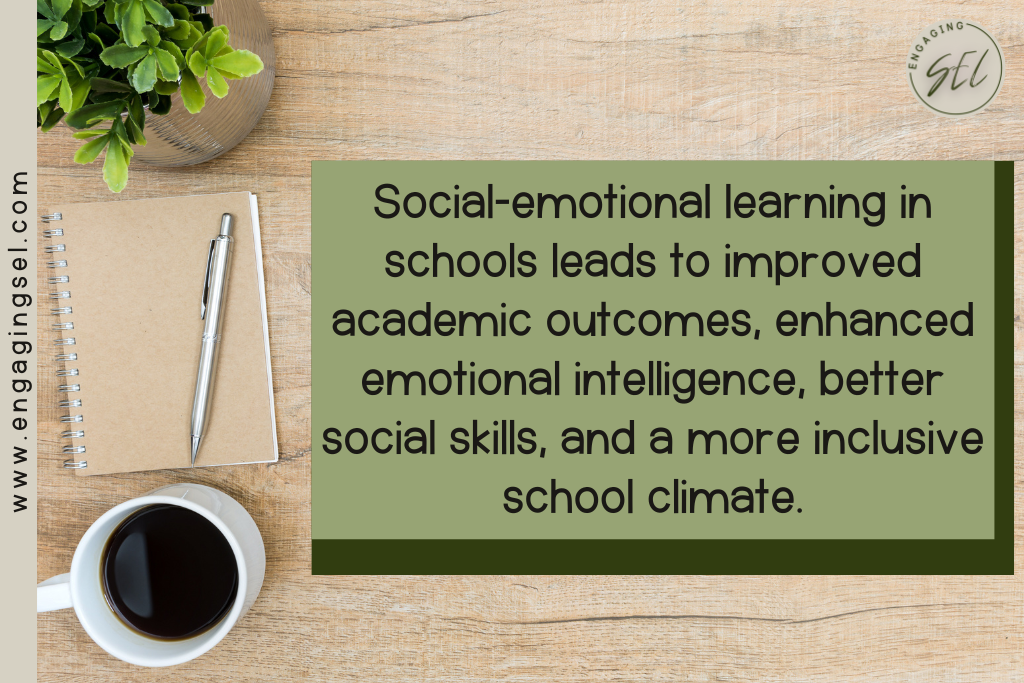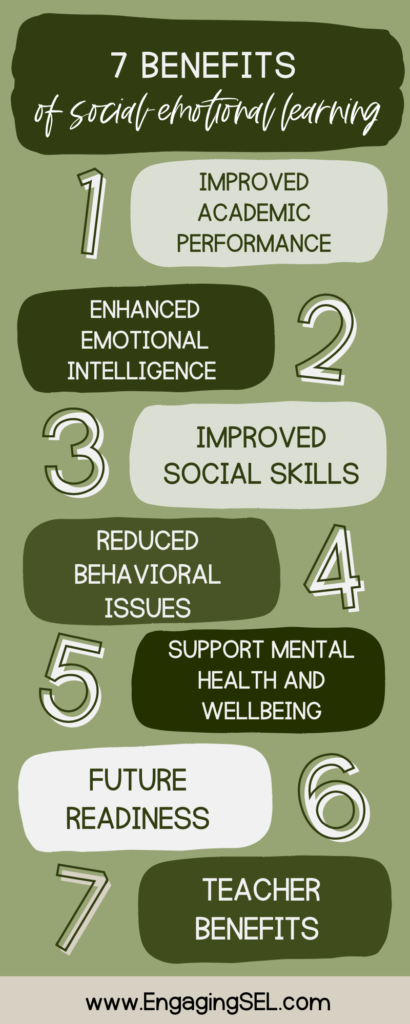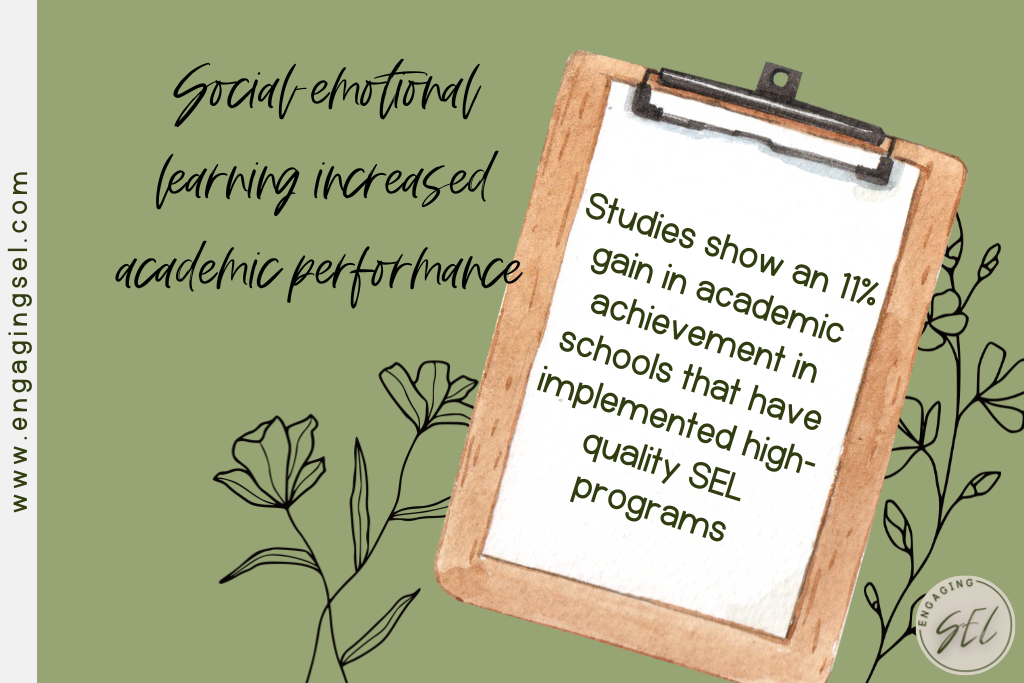
You might have heard of the term SEL or social-emotional learning in some way, shape, or form already if you are in the world of education but why is it so important and why should you be teaching it? Social-emotional learning is the process through which people develop skills in the areas of self-awareness, self-management, social awareness, relationship skills, and responsible decision-making. Teaching SEL in schools gives students the skills they need to be successful in school and in life. This blog post explores the many benefits of teaching students social-emotional learning in the elementary classroom.

Improved Academic Performance
One of the most impactful results from the integration of SEL programs in schools is academic gain. Studies show an 11% gain in academic achievement in schools that have implemented high-quality SEL programs (Durlak et al.2019). SEL helps increase the positive behaviors in a school which also helps raise student academic performance (Weissburg). When students are emotionally supported and understood and have their needs met they are more engaged and motivated to learn which leads to improved academic performance. CASEL shared that students participating in SEL programs show improved levels of school functioning such as grades, test scores attendance, and homework completion. Simply put, when students are taught how to regulate their emotions, get along with others, and make good choices, they are more able to positively contribute to the learning environment, stay engaged, be more involved in learning, and perform better academically.
Enhanced Emotional Intelligence
Teaching life skills or social-emotional skills helps students increase their emotional intelligence, which is the ability to manage one’s emotions and understand the emotions of others(Mental Health America). Students can identify their emotions, which helps them plan to manage those emotions better. Students develop tools to express themselves constructively and cope with the emotions they are experiencing. CASEL states that SEL enhances coping skills, and resiliency and supports emotional identification to reduce symptoms of depression and anxiety in the classroom.

Improved Social Skills
Social-emotional learning teaches effective communication skills, conflict resolution, and active listening which all improve students’ social skills. Students learn how to work with each other in the classroom and learn skills for later in life. Some other benefits of SEL in the classroom are increased empathy, reduced behavior problems, and an increase in collaborative learning (Kirsten, 2020). Students who are more socially aware are less likely to engage in risky behaviors such as bullying (Connelly, 2020).
Reduced Behavioral Issues
Panorama Education shares that SEL interventions can help prevent discipline issues before they happen. Teachers can use social-emotional learning strategies to create a safe, collaborative learning community with SEL leads to improved classroom behavior with fewer conduct issues, and a reduction in bullying and aggression. SEL reduces problem behaviors through teaching coping skills, impulse control, self-regulation, and problem-solving.

Supports Mental Health and Wellbeing
Teaching SEL in the classroom gives students strategies to handle stress, anxiety, and depression to support students’ well-being. CASEL shared that explicit teaching of SEL in schools leads to decreased emotional distress, more positive attitudes about self and others, enhanced coping skills, and resiliency. By including discussions about emotions and mental well-being into the classroom, SEL fosters a supportive environment where students feel comfortable seeking help when needed.

Future Readiness
Students learn resilience, adaptability, and responsible decision-making which are skills that are necessary for college and career readiness. SEL prepares students for personal and professional challenges they may face in their adult lives. Students will become compassionate citizens able to positively contribute to their community as a result of learning SEL skills in school. CASEL states that students with strong SEL skills are more likely to graduate high school, attend or complete post-secondary school, and have stable employment.
Teacher Benefits
SEL is not just for students. Teachers can benefit from SEL skills too! With the use of SEL strategies, teachers can control their reactions to difficult situations and manage their emotions effectively. Teachers with strong SEL skills have a higher level of job satisfaction, less burnout, improved relationships with students, and more effective class management skills. In other words, teachers who are able to manage their emotions effectively, and have strong communication and relationship skills, will be better able to build relationships with students and create a safe, supportive environment.
Conclusion
The benefits of social-emotional learning go far beyond the classroom walls and give students tools they can use for life. Improved academic outcomes, enhanced emotional intelligence, better social skills, and a more inclusive school climate are just a few of the many advantages of teaching SEL in schools. If you are interested in learning more about SEL check out my blog about what SEL is and why it is important. If you are not sure where to start with teaching SEL in your classroom or you are ready to get started, check out my SEL curriculum designed to be flexible enough to work for any classroom schedule. With all of these benefits for adults and students, teaching social-emotional learning is a no-brainer. I am here to help you get started teaching SEL in your classroom today!
Mindfully yours,
Alyssa from Engaging SEL
References
CASEL https://casel.org/fundamentals-of-sel/what-does-the-research-say/
Durlak, J. A., Weissberg, R. P., Dymnicki, A. B., Taylor, R. D., & Schellinger, K. B. (2011). The impact of enhancing students’ social and emotional learning: A meta-analysis of school-based universal interventions. Society for Research in Child Development, 82(2), 405–432. https://doi.org/10.1111/j.1467-8624.2010.01564.x
Kirsten. (2020, August). Managing emotions with self-management skills and resources. https://childrenslibrarylady.com/managing-emotions-resources/
Mental Health America https://mhanational.org/what-emotional-intelligence-and-how-does-it-apply-workplace#:~:text=Emotional%20Intelligence%20(EI)%20is%20the,%2C%20empathy%2C%20and%20social%20skills.
Weissberg, R. P. (2019). Promoting the social and emotional learning of millions of school children. Perspectives on Psychological Science, 14(1), 65–69. https://doi.org/10.1177/1745691618817756


